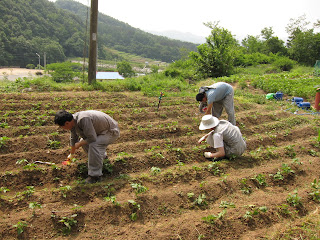Awareness “Fuel”
Being a kindergarten teacher here in Seoul, Korea, I’ve found that recognition of mistakes and that making simple corrections to those mistakes is a daily practice in the classroom. It’s simply amazing to notice just how different every child is, but also how they all share a basic understanding that their classmates – just like them – don’t want to suffer. Most conflicts between the children are resolved by using a calm, compassionate voice to remind them of those beautiful words, “I’m sorry” with a reply from the other, “That’s OK.” In almost all situations, the children not only mentally move on with their day, but even start to play with each other immediately after. So much can be learned from them! They don’t hold onto those past grievances, probably because they want to be happy every moment and they just instinctively know being present is the way to do that!

I must admit, however, that I have made many mistakes with the children: I’ve scolded them harshly when they really needed compassion and I cannot count how many times I’ve allowed myself to become impatient and even angry over minor problems. Before I started meditating regularly several months ago these occurrences were quite frequent – many times a day – but as my practice has gotten stronger, so has my awareness in the classroom, and these occasions have decreased significantly. Another aspect of this increased awareness has been recognizing when I have made mistakes with the children, and then working to forgive myself. This is actually a new practice for me, and one that I am eager to explore more.
The three-hour commute one-way from my house in Seoul to practice at Mu Sang Sa is so worth it every single time as it gives me new awareness “fuel” for the rest of the week. To be sure, my students are all happier, too!
AR, USA
~~~~~~~~~~~~~
無上寺
2010年,有幸參加韓國無上寺的夏安居禪修營。如今雖然事隔已經半年多了,現在回想起來,真的有許多難以忘懷的事情,也有許多值得回憶的點滴。
無上寺的風景怡人、四面都是綠油油的叢林、鳥語花香。還有溪水潺流。在這裡禪修打坐,妄念都難起。每天凌晨三點多,就已經起床108拜、誦經、靜坐。生活簡單、規律、樸實,卻又不失踏實與充實。最期待的是每一個星期,都會有一天可以去-爬山!我們這一屆的,還有機會爬最難爬的山,也是最刺激、最開心的登山天。感謝我們的HEAD MONK。
無上寺有一片土地,是栽種了一些蔬菜與果實。我們在這期間,也在Myong An師的帶領下,戴起手套,穿起農耕鞋,一起幹活去!看著一些露出土壤的馬鈴薯,還沒吃就感覺到了它們的清甜。
學員們一個星期都會有兩次的小參,直接被禪師勘驗。
這裡講究的是Together Action。這是一種可嘉的精神,無形中,也培養我們的同理心、平等心。最難忘的是,第一次過堂吃飯!過堂吃飯是有一定的程序。每一個步驟,都要在指定的時間內完成,而且是全體學員一致性的,不是你做你的,我行我的。動筷一起動、直至最後放下筷子,都是Together Action。哦!如果沒來得及吃完呢,那怎麼辦?這樣的“驚驗”,只有自己去體驗咯。
無上寺,是非常難得的無上-寺。
清月 , Malaysia
~~~~~~~~~~~~~
What else do you know or need to know?
I first visited Mu Sang Sa in November 2008 on the recommendation of a Korean monk I have known for about 10 years now. He put me in contact with Bo Haeng Sunim and after talking a bit on the phone, I went there to meet him one Sunday. On my first visit I immediately felt in awe that such a quiet, fresh-aired place that could be found in Korea. That first impression came from the fact that in Korea, life usually takes place in some kind of big-city environment. Mu Sang Sa seemed to be an anomaly. But still, that was just the initial visit, and only later on was I able to learn what the temple itself and practice were about. I came every chance I could to the weekend class and Dharma talk. Sometimes I came together with another western friend and we joked that it was our weekly pilgrimage from Daejeon. I guess that having a ‘don’t know, just do it’ mind helped me to get on the bus each time and make the journey. One hour of sitting during the class was torture at first but later it was no big deal. I came for the Chuseok retreat and then made other visits when I was off from work. After finishing a retreat, one hour seemed to be a suitable period for me for sit. I eventually started sitting at home.

I feel now that I am truly fortunate for having discovered Mu Sang Sa. I was a person just like any other out in the working world with a broken radio going on inside my head. Or really what I perceived was inside my head. In everyday life we can learn better how to function with a ‘don’t know’ mind and still hear the bells of mindfulness when they ring. Too many of us wake up each day and ask ourselves, ‘How can I just be happy?’ when we should just throw away that question entirely and look out to see the sky is blue, that’s all. What else do you know or need to know?
This year I will go back to the US for a while but when I return to Korea I am hoping to visit Mu Sang Sa again when I can. For anyone who’s interested in learning more about sitting meditation and practice, I wholly suggest that you go to Mu Sang Sa.
WC, USA














